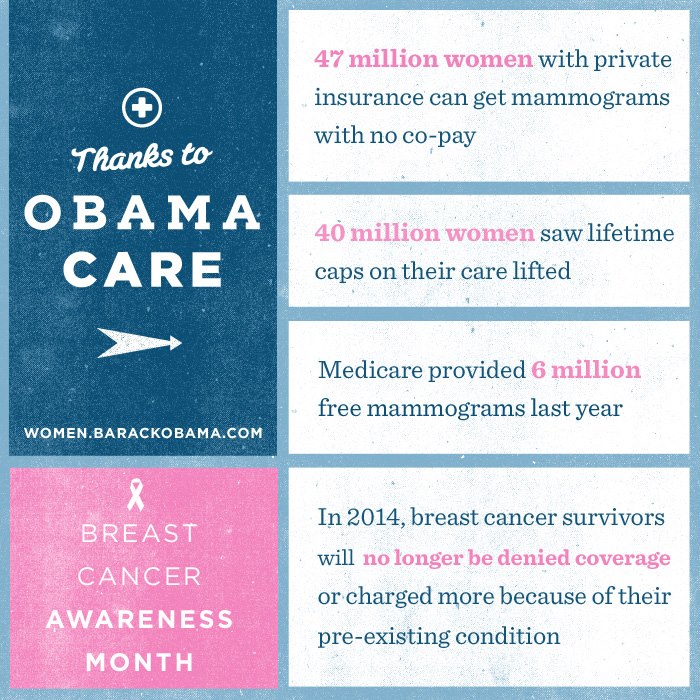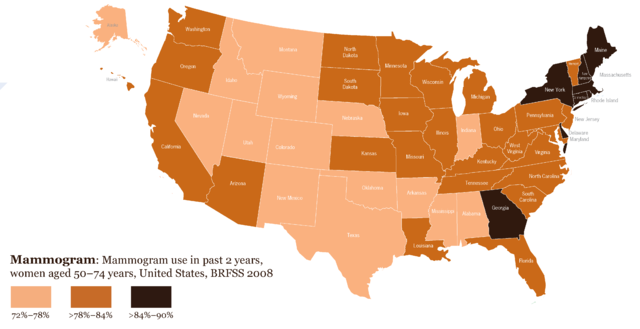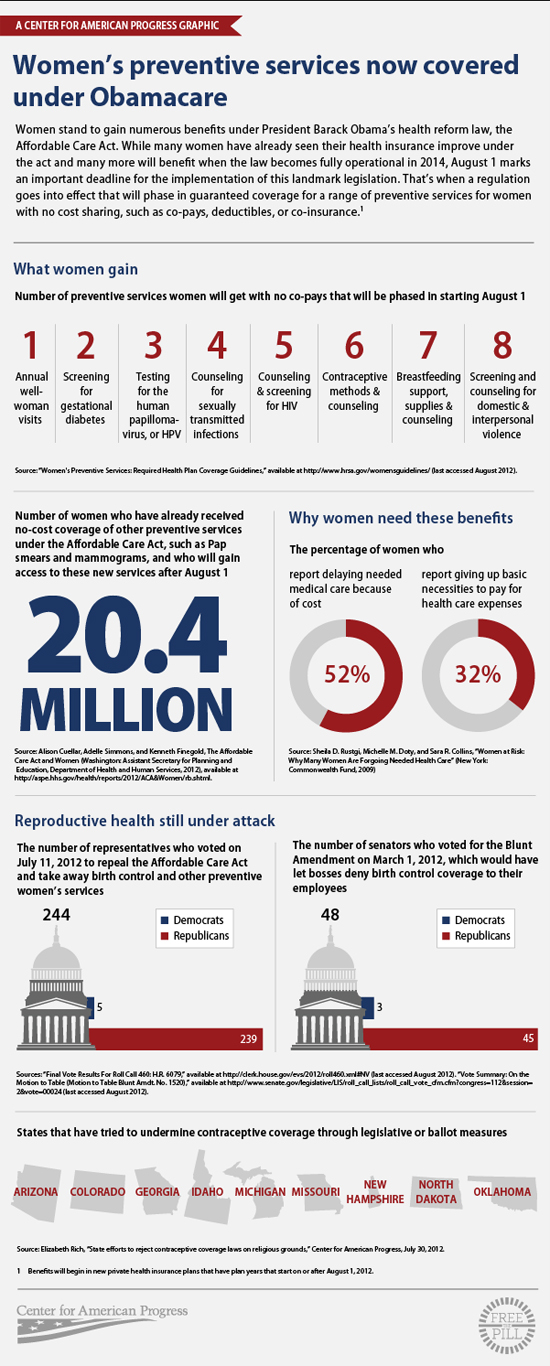ObamaCare and Women: ObamaCare Women’s Health Services








ObamaCare Ensures Women Get Equal Health Care Rights and Improved Women’s Health Services
How Does ObamaCare Benefit Women? ObamaCare gives women access to guaranteed preventive women’s health services with no copayment or coinsurance even if they haven’t met their deductible. See: Preventive care benefits for women at HealthCare.gov for a list of services covered.
Before the Affordable Care Act (ObamaCare) many women’s health services were not covered, or were only offered via co-pays or deductibles. Today, under the Affordable Care Act, a large array of important preventative women’s health services are covered.
Aside from preventive services, women’s benefits also include free wellness visits and provisions protecting women from gender discrimination.
Find out more about ObamaCare and women’s health services, and how the ObamaCare addresses others women’s health issues.
IMPORTANT: Covered women’s health services are only free when delivered by a doctor or other provider in a plan’s network and only plans that have to comply with the Affordable Care Act cover these services.
 New Preventive Services for Women
New Preventive Services for Women
Women across America will benefit from the new provisions and protections in the Affordable Care Act (ObamaCare).
Under the Affordable Care Act women have access to a large number of preventive services at no cost on health coverage that has to follow the Affordable Care Act’s rules (for example marketplace plans and full benefit employer plans). These services include:
• Well-woman visits.
• Gestational diabetes screening that helps protect pregnant women from one of the most serious pregnancy-related diseases.
• Domestic and interpersonal violence screening and counseling.
• FDA-approved contraceptive methods, and contraceptive education and counseling.
• Breastfeeding support, supplies, and counseling.
• HPV DNA testing, for women 30 or older.
• Sexually transmitted infections counseling for sexually-active women.
• HIV screening and counseling for sexually-active women.
• Mammograms and Colonoscopies (since Sept 2010)
• And more.
ObamaCare: Focusing on Preventive Services for Women
President Obama said it well when he said, “ObamaCare doesn’t regulate health care, it regulates health insurance.” In other words, the ACA doesn’t tell women what services they can get, it tells insurers what services they have to offer at no cost.
ObamaCare ensures that women have access to preventive services. Providing better preventive care for women will help to bring down the cost of insurance by preventing minor health issues from becoming major ones. This insurance reform helps to ensure that women stay healthy and avoid preventable medical problems.
ObamaCare Women’s Health Fact: Over half the women in the United States have avoided or delayed preventive care due to cost. The ACA helps solve that problem by ensuring important preventative measures aren’t put off due to cost for those with coverage.
Below is a infographic created right before the new ObamaCare Women’s Health Benefits went into effect. Since then, millions of women have taken advantage of these new health benefits and health services.
Types of Preventive Services For Women, HHS Guidelines for Coverage, and Frequency
The following guidelines explain some of the preventive services offered to women in more detail. See HRSA.Gov guidelines for more details.
| Type of Preventive Service | HHS Guideline for Health Insurance Coverage | Frequency |
|---|---|---|
| Well-woman visits. | Well-woman preventive care visit once a year for adult women so that they can obtain recommended preventive services that are age and developmentally appropriate, including preconception care and many services necessary for prenatal care. This well-woman visit should, where appropriate, include other preventive services listed in this set of guidelines, as well as others referenced in section 2713. | Annual, although HHS recognizes that several visits may be needed to obtain all necessary recommended preventive services, depending on a woman’s health status, health needs, and other risk factors.* (see note) |
| Screening for gestational diabetes. | Screening for gestational diabetes. | In pregnant women between 24 and 28 weeks of gestation and at the first prenatal visit for pregnant women identified to be at high risk for diabetes. |
| Human papillomavirus testing. | High-risk human papillomavirus DNA testing in women with normal cytology results. | Screening should begin at 30 years of age and should occur no more frequently than every 3 years. |
| Counseling for sexually transmitted infections. | Counseling on sexually transmitted infections for all sexually active women. | Annual. |
| Counseling and screening for human immune-deficiency virus. | Counseling and screening for human immune-deficiency virus infection for all sexually active women. | Annual. |
| Contraceptive methods and counseling. ** (see note) | All Food and Drug Administration approved contraceptive methods, sterilization procedures, patient education, and counseling for all women with reproductive capacity. | As prescribed. |
| Breastfeeding support, supplies, and counseling. | Comprehensive lactation support and counseling by a trained provider during pregnancy and/or in the postpartum period, and costs for renting breastfeeding equipment. | In conjunction with each birth. |
| Screening and counseling for interpersonal and domestic violence. | Screening and counseling for interpersonal and domestic violence. |
New Health Care Benefits for Women
Not only does ObamaCare provide a number of required preventative and wellness services, it also contains a number of additional benefits. Here is a summary of new benefits for women under the Affordable Care Act from Think Progress. This portion of the page was written on May 2012 before many of the Affordable Care Act’s key provisions went into place. Many of the benefits and projections have now come into fruition. In a few places we updated the information below to make sense as of August 2015.
“1. Obamacare guarantees coverage of preventive services with no cost sharing. Preventive care promotes health and saves money, yet many preventive care services are out of women’s reach due to high co-pays, deductibles, and co-insurance. Before ObamaCare more than 50 percent of women delayed seeking medical care due to cost, and one-third of women reported forgoing basic necessities to pay for health care. However, under the ACA, insurers are now required to cover recommended preventive services such as mammograms, Pap smears, and well-baby care without cost sharing. More than 45 million women had already taken advantage of these services by May 2012 and the numbers have only increased since then. As of this August 2012 more services, including contraception, gestational diabetes screening, and breastfeeding supports, have been added to the list of preventive care that must be covered at no additional cost.
2. Maternity care will be required in new insurance plans. Coverage for maternity care—health care that only women need—is routinely excluded in the individual insurance market. Before ObamaCare only 12 percent of plans sold in the individual market offered maternity coverage. This coverage was frequently inadequate because of waiting periods or deductibles that can result in costs as high as those involved in the birth itself. In 2012 about 8.7 million women were projected to gain guaranteed access to maternity care in all new individual and small group plans.
3. Women will no longer be denied insurance coverage for gender-related reasons. Before ObamaCare it was common for insurers to refuse to cover women because of gender-based “pre-existing conditions,” such as having had a Cesarean section or being the victim of domestic violence or sexual assault. This practice was outlawed under ObamaCare starting in 2014. From the time the ACA was signed in 2010 until 2014, adults with pre-existing conditions who have been uninsured for at least six months could purchase affordable coverage through temporary Pre-existing Condition Insurance Plans.
4. Women will no longer be charged more for their insurance coverage just for being women. Under a practice known as “gender rating,” insurers tended to charge women higher premiums than men for identical health benefits. As a result, before the ACA women paid $1 billion more than men each year for the same health plans in the individual market before ObamaCare. As of 2014, however, under the Affordable Care Act, gender rating has become illegal in all new individual and small group plans.
5. Women have more control over their health care. Women no longer need a referral to see their obstetrician-gynecologist thanks to Obamacare, and they may choose their primary care physician and their child’s pediatrician from their plan’s list of participating providers.
6. Women will gain better access to affordable health insurance. Starting in 2014 women and their families, as well as small businesses, have been eligible to receive tax credits on an income-based sliding scale to help purchase insurance coverage. This will help individuals who earn up to $47,080 per year, and up to $97,000 for families of four (these are 2015 numbers, they increase every year based on the Federal Poverty Level). Also in 2014 up to 10.3 million women were supposed to gain access to insurance coverage when Medicaid expanded its income eligibility to include people with incomes below 138 percent of the federal poverty level—less than $15,654 for individuals and about $32,253 for a family of four in 2015. The health law also eliminates Medicaid’s categorical requirements, so that low-income women who meet the income requirements can be enrolled even if they have no children and are not pregnant in states that chose to accept this provision. However 20 states have opted-out of expanding Medicaid as of August 2015.
7. Insurance companies can no longer place limits on the amount of money they will spend on covered medical expenses. Women are more likely than men to suffer from chronic conditions. An unforeseen medical emergency or a chronic illness can cause an insured person to rapidly reach a coverage cap in their insurance plan, leaving enrollees to fend for themselves, sometimes with thousands of dollars in unpaid medical bills. Under Obamacare lifetime coverage caps have been eliminated, and annual limits are being phased out. Approximately 39.5 million women had already benefited from the ban on lifetime caps as of May 2012.
8. Women and their families benefit from critical consumer protections in Obamacare. Because women use health care services at higher rates than men on behalf of themselves and their families, ensuring fair insurance practice is of critical importance. The Affordable Care Act has already eliminated the practice of “rescission.” Insurance policies have been allowed to be rescinded, or taken away, when a beneficiary gets sick. They are no longer allowed to do this. The health law also requires insurers to spend at least 80 percent of premiums on actually providing health care, as opposed to administrative costs, or pay enrollees a rebate. About 12.5 million received $1.1 billion in rebates in 2012 alone.
9. Women in marginalized communities are seeing reforms that respond to their needs. Before the ACA women of color, lesbian and bisexual women, and transgender people were disproportionately uninsured and subject to higher rates of health insurance. Obamacare is making critical strides in providing these vulnerable women with quality health care through increasing access to insurance coverage, increasing funding for community health centers, improving health literacy and cultural competency, prohibiting discrimination in the health insurance market, and improving data collection. As of 2012 an estimated 5.5 million African Americans, 6.1 million Latinos, 2.7 million Asians, and 0.3 million Native Americans, many of them women, had already received preventive service coverage with no cost sharing under the health reform law.
10. Mothers have peace of mind, knowing that their children have health insurance. Obamacare prohibits insurers from denying coverage to children under age 19 because of pre-existing conditions, and adult children can now stay on a parent’s plan up to age 26, an especially helpful provision in this tough economy, where finding a job with benefits can be very challenging. Young women, in particular, report delaying needed health care because of high costs. In 2010 about 30% of Americans between the ages of 19 and 29 had no health insurance. As of 2015, 5.7 million young adults had gained coverage under the Affordable Care Act. Today the ”
The Healthy Teen Initiative to Prevent Teen Pregnancy
One provision of ObamaCare that will have an effect on young women across America is called “the Healthy Teen Initiative to Prevent Teen Pregnancy”. This initiative is one of the most important, and most controversial aspects of ObamaCare. It is the focus on preventing teen pregnancy by using evidence based, scientifically collected and medically based data, and methodologically sound research to:
(1) To delay initiation of sex,
(2) To decrease number of partners,
(3) To reduce teen pregnancy,
(4) To reduce sexually transmitted infection,
(5) To improve rates of contraceptive use.
Government funding goes to institutions who choose the accept the funds (they can decline both the funds and services on religious grounds). While some of the services are controversial, these services only comprise a small part of the bill. Much of the money spent on the Healthy Teen Initiative is meant to prevent STDs, and provide education that helps prevent teen pregnancy. Only a small portion is spent on controversial services.

ObamaCare Provides Affordable Access to Women’s Services
ObamaCare provides women with affordable access to health services. While many services are provided free (with insurance), not all women’s health preventive services are required to be covered by law. ObamaCare does however, help to reduce the cost of many women’s health services and expands coverage to more women.
ObamaCare Women’s Health Fact: ObamaCare prohibits health plans from requiring a referral from a primary care provider before seeking coverage for obstetrical or gynecological (OB-GYN) care from a participating OB-GYN specialist.
 ObamaCare and Contraception
ObamaCare and Contraception
The issue of contraception is central to a discussion of insurance law and women’s health. Contraception can cost women up to $600 a month out of pocket without adequate insurance. The less money you make, the more difficult it is to pay for this. The results of health service not being available to all women equally because of cost has had a great effect on pregnancy rates, the frequency of STDs, and a number of other related issues.
While you may not agree with women taking contraceptives, it’s important to note that ObamaCare takes women’s health care out of the hands of insurance companies and puts it back into their own hands. Giving women access to contraception gives women the right to choose and increases their economic security.
ObamaCare and Women’s Right to Health Care
Women have gained significant control over their health care from ObamaCare. It’s up to each women to decide for herself what health care she will use. Here are some things you should be aware of:
1. Insurance companies may try to grandfather you into plans that don’t cover treatments mandated by ObamaCare. Although all new plans will have to cover wellness and preventive services for women, older plans can “grandfather you in” to plans that don’t cover these services.
2. Most of the ObamaCare’s guaranteed services, which help 47 million American women get better access to better healthcare, aren’t controversial at all. Don’t give up your right to services such as annual well-woman visits or free preventive screenings because you personally would not chose to use birth control, and remember that abortion is not covered by any federal money whatsoever. Standing against the whole bill for a small portion of it may not be your best course of action.
Women’s Health Services and ObamaCare in Summary
With 47 million women receiving unprecedented coverage for preventive services, wellness service,s and access to more comprehensive and fairer priced insurance, you would assume that just about every woman in America would support the bill. You would be wrong in this assumption. Many women oppose the bill. In fact 33% of Americans (men and women) still want to see the bill repealed.
If you support the Women’s Health Services in ObamaCare, get the word out and help others to understand them too.
If you disagree with aspects of ObamaCare and how it affects women, make sure you are fighting against a specific aspect of the bill. Remember ObamaCare benefits millions of people across the United States. Thanks for learning about ObamaCare and women’s health services.
Women’s Health and ObamaCare
![]()
